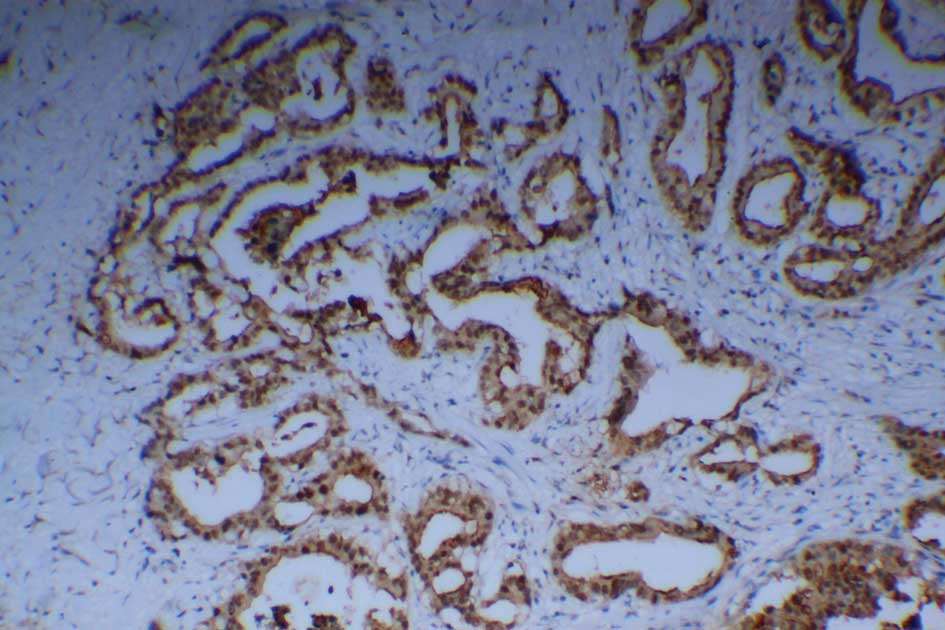|
1
|
Skipworth JR, Olde Damink SW, Imber C, et
al: Review article: surgical, neo-adjuvant and adjuvant management
strategies in biliary tract cancer. Aliment Pharmacol Ther.
34:1063–1078. 2011. View Article : Google Scholar : PubMed/NCBI
|
|
2
|
Blechacz B, Komuta M, Roskams T and Gores
GJ: Clinical diagnosis and staging of cholangiocarcinoma. Nat Rev
Gastroenterol Hepatol. 8:512–522. 2011. View Article : Google Scholar : PubMed/NCBI
|
|
3
|
Yamamoto M and Ariizumi S: Surgical
outcomes of intrahepatic cholangiocarcinoma. Surg Today.
41:896–902. 2011. View Article : Google Scholar : PubMed/NCBI
|
|
4
|
Wadsworth CA, Dixon PH, Wong JH, et al:
Genetic factors in the pathogenesis of cholangiocarcinoma. Dig Dis.
29:93–97. 2011. View Article : Google Scholar : PubMed/NCBI
|
|
5
|
Akamatsu N, Sugawara Y and Hashimoto D:
Surgical strategy for bile duct cancer: advances and current
limitations. World J Clin Oncol. 2:94–107. 2011. View Article : Google Scholar : PubMed/NCBI
|
|
6
|
Friman S: Cholangiocarcinoma - current
treatment options. Scand J Surg. 100:30–34. 2011.PubMed/NCBI
|
|
7
|
Tyson GL and El-Serag HB: Risk factors for
cholangiocarcinoma. Hepatology. 54:173–184. 2011. View Article : Google Scholar
|
|
8
|
Morise Z, Sugioka A, Tokoro T, et al:
Surgery and chemotherapy for intrahepatic cholangiocarcinoma. World
J Hepatol. 2:58–64. 2010.PubMed/NCBI
|
|
9
|
Ellis MC, Cassera MA, Vetto JT, et al:
Surgical treatment of intrahepatic cholangiocarcinoma: outcomes and
predictive factors. HPB (Oxford). 13:59–63. 2011. View Article : Google Scholar : PubMed/NCBI
|
|
10
|
Fava G: Molecular mechanisms of
cholangiocarcinoma. World J Gastrointest Pathophysiol. 1:12–22.
2010.
|
|
11
|
Lutz W, Leon J and Eilers M: Contributions
of Myc to tumorigenesis. Biochim Biophys Acta. 16:61–71. 2002.
|
|
12
|
Dang CV: c-Myc target genes involved in
cell growth, apoptosis, and metabolism. Mol Cell. 19:1–11.
1999.PubMed/NCBI
|
|
13
|
Henriksson M and Luscher B: Proteins and
the Myc network: essential regulators of cell growth and
differentiation. Adv Cancer Res. 68:109–182. 1996. View Article : Google Scholar : PubMed/NCBI
|
|
14
|
Cowling VH and Cole MD: HATs off to
capping: a new mechanism for Myc. Cell Cycle. 6:307–309. 2007.
View Article : Google Scholar : PubMed/NCBI
|
|
15
|
Prochownik EV and Li Y: The ever expanding
role for c-Myc in promoting genomic instability. Cell Cycle.
6:1024–1029. 2007. View Article : Google Scholar : PubMed/NCBI
|
|
16
|
Schick B, Wemmert S, Jung V, et al:
Genetic heterogeneity of the MYC oncogene in advanced juvenile
angiofibromas. Cancer Genet Cytogenet. 164:25–31. 2006. View Article : Google Scholar : PubMed/NCBI
|
|
17
|
Jain M, Arvanitis C, Chu K, et al:
Sustained loss of a neoplastic phenotype by brief inactivation of
MYC. Science. 297:102–104. 2002. View Article : Google Scholar : PubMed/NCBI
|
|
18
|
Tsuneoka M, Koda Y, Soejima M, et al: A
novel myc target gene, mina53, that is involved in cell
proliferation. J Biol Chem. 277:35450–35459. 2002. View Article : Google Scholar : PubMed/NCBI
|
|
19
|
Tsuneoka M, Nishimune Y, Ohta K, et al:
Expression of Mina53, a product of a Myc target gene in mouse
testis. Int J Androl. 29:323–330. 2006. View Article : Google Scholar : PubMed/NCBI
|
|
20
|
Prendergast GC: Mechanisms of apoptosis by
c-Myc. Oncogene. 18:2967–2987. 1999. View Article : Google Scholar : PubMed/NCBI
|
|
21
|
Obaya AJ, Mateyak MK and Sedivy JM:
Mysterious liaisons: the relationship between c-Myc and the cell
cycle. Oncogene. 18:2934–2941. 1999. View Article : Google Scholar : PubMed/NCBI
|
|
22
|
Kuratomi K, Yano H, Tsuneoka M, et al:
Immunohistochemical expression of Mina53 and Ki67 proteins in human
primary gingival squamous cell carcinoma. Kurume Med J. 53:71–78.
2006. View Article : Google Scholar : PubMed/NCBI
|
|
23
|
Tsuneoka M, Fujita H, Arima N, et al:
Mina53 as a potential prognostic factor for esophageal squamous
cell carcinoma. Clin Cancer Res. 10:7347–7356. 2004. View Article : Google Scholar : PubMed/NCBI
|
|
24
|
Teye K, Tsuneoka M, Arima N, et al:
Increased expression of a Myc target gene Mina53 in human colon
cancer. Am J Pathol. 164:205–216. 2004. View Article : Google Scholar : PubMed/NCBI
|
|
25
|
Vousden KH: P53: death star. Cell.
103:691–694. 2000. View Article : Google Scholar : PubMed/NCBI
|
|
26
|
Levine AJ: P53, the cellular gatekeeper
for growth and division. Cell. 88:323–331. 1997. View Article : Google Scholar : PubMed/NCBI
|
|
27
|
Vogelstein B, Lane D and Levine AJ:
Surfing the p53 network. Nature. 408:307–310. 2000. View Article : Google Scholar : PubMed/NCBI
|
|
28
|
Jiang XH, Chun YWB, Yuen ST, et al:
Arsenic trioxide induces apoptosis in human gastric cancer cells
through up-regulation of p53 and activation of caspase-3. Int J
Cancer. 91:173–179. 2001. View Article : Google Scholar : PubMed/NCBI
|
|
29
|
Yin XY, Grove L, Datta NS, et al: C-myc
overexpression and p53 loss cooperate to promote genomic
instability. Oncogene. 18:1177–1184. 1999. View Article : Google Scholar : PubMed/NCBI
|
|
30
|
Hong S, Pusapati RV, Powers JT and Johnson
DG: Oncogenes and the DNA damage response: Myc and E2F1 engage the
ATM signaling pathway to activate p53 and induce apoptosis. Cell
Cycle. 5:801–803. 2006. View Article : Google Scholar : PubMed/NCBI
|
|
31
|
Schlüter C, Duchrow M, Wohlenberg C, et
al: The cell proliferation-associated antigen of antibody Ki67: a
very large, ubiquitous nuclear protein with numerous repeated
elements, representing a new kind of cell-cycle-maintaining
proteins. J Cell Biol. 123:513–522. 1993.
|












